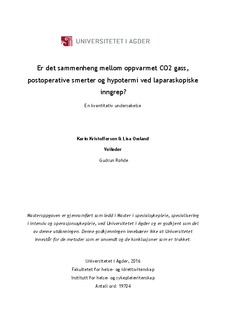| dc.contributor.author | Kristoffersen, Karin | |
| dc.contributor.author | Omland, Lisa | |
| dc.date.accessioned | 2016-10-10T10:10:02Z | |
| dc.date.available | 2016-10-10T10:10:02Z | |
| dc.date.issued | 2016 | |
| dc.identifier.uri | http://hdl.handle.net/11250/2413854 | |
| dc.description | Masteroppgave i spesialsykepleie – Universitetet i Agder 2016 | nb_NO |
| dc.description.abstract | Background: A common complication to laparoscopic procedures is postoperative shoulder pain. As a result of a surgical procedure, the patient is also exposed to hypothermia. There are various theories of the causes of postoperative shoulder pain and hypothermia. One of them suggest that the internal environment in the abdomen changes by insufflation of standard CO2 gas, and that this may result in peritoneal changes. Previous studies show that heated CO2 gas can reduce postoperative pain and hypothermia by laparoscopic surgery. Surgical and intensive patient is in a vulnerable situation, and the reflection on the operation and intensive care to these patients are important.
Aim: The aim of this study is to see if there is a correlation between heated CO2 gas, postoperative pain and hypothermia, as well to see what surgery and intensive nurse can contribute to preventing these complications.
Method: A retrospective record review of patients who have undergone laparoscopic cholecystectomi or gynecological laparoscopy. A total of 170 patient records were scrutinized. Of these patients, 86 patients received standard CO2 gas, and 84 patients received heated CO2 gas. All patients belong to the same hospital. The data were analyzed using descriptive and comparative statistics.
Results: Patients who received heated CO2 gas had less need for strong opioids in postoperative department and 1.st postoperative day, and had higher mean body temperature than patients who received standard CO2 gas. An additional finding were missing VAS and temperature registration.
Conclusion: There is a correlation between heated CO2 gas, postoperative pain and hypothermia. It should be established better systems for documentation of nursing intervention exerted in hospitals
Key words: Postoperative shoulder pain, hypothermia, insufflation of CO2 gas, intensive care nurse, surgical nurse, vulnerability | nb_NO |
| dc.language.iso | nob | nb_NO |
| dc.publisher | Universitetet i Agder ; University of Agder | nb_NO |
| dc.subject | postoperative skuldersmerter | nb_NO |
| dc.subject | hypotermi | nb_NO |
| dc.subject | insufflasjon av CO2 gass | nb_NO |
| dc.subject | intensivsykepleiere | nb_NO |
| dc.subject | operasjonssykepleiere | nb_NO |
| dc.subject | sårbarhet | nb_NO |
| dc.subject | postoperative shoulder pain | nb_NO |
| dc.subject | hypothermia | nb_NO |
| dc.subject | insufflation of CO2 gas | nb_NO |
| dc.subject | intensive care nurses | nb_NO |
| dc.subject | surgical nurses | nb_NO |
| dc.subject | vulnerability | nb_NO |
| dc.subject.classification | ME519 | |
| dc.title | Er det sammenheng mellom oppvarmet CO2 gass, postoperative smerter og hypotermi ved laparaskopiske inngrep? : en kvantitativ undersøkelse | nb_NO |
| dc.type | Master thesis | nb_NO |
| dc.subject.nsi | VDP::Medical disciplines: 700::Clinical medical disciplines: 750 | nb_NO |
| dc.source.pagenumber | [79] s. | nb_NO |
